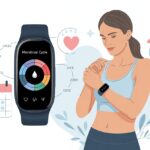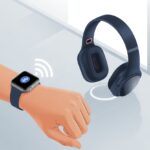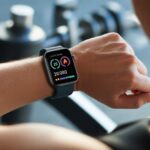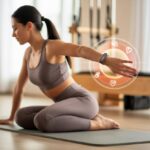Honestly, who really knows what goes on while we sleep? We shut our eyes and hope eight hours later we’ll feel rested, but it’s a mystery. Thankfully, fitness trackers do more than just buzz us awake—they actually give us a peek into what happens at night. When we wear a fitness tracker to bed, we can track our sleep patterns, see when we woke up, and figure out if we got any real rest at all.

Here’s the best part: we don’t have to be tech experts. Most trackers make it super easy to start tracking our sleep with just a few taps on our phones.
If you’re curious how these gadgets work, they use sensors to watch our movements and heart rate. That helps us get a pretty good idea of our sleep stages and how much rest we actually got, as Live Science’s guide to sleep tracking explains.
Ever wondered why you’re still tired after sleeping in, or how often you toss around all night? Sleep tracking is here to help us figure that out. Ready to turn those nightly zzz’s into data (and maybe brag about your best sleep score)? Let’s see how to actually make the most of our fitness trackers at night.
What Is Sleep Tracking And Why Use a Fitness Tracker?
Sleep tracking is kind of like strapping a mini scientist to your wrist. These clever little wearables record how long we sleep, track our movements, and sometimes even catch how much we snore.
With all that info, we can start figuring out how to sleep better and wake up less groggy.
Benefits of Monitoring Sleep
Honestly, most of us have no clue if we actually slept for eight hours or just spent half the night thinking about pizza. Sleep trackers help us see our sleep habits and patterns.
Spotting problems like waking up too often or missing out on deep sleep gets a lot easier. Knowing what’s really happening can lead to changes that actually help. Maybe we notice bedtime movies keep us up, or that a little exercise means we sleep longer.
Sleep trackers call us out on bad habits, too. They might nudge us to skip late-night snacks or cut back on caffeine.
Doctors and experts keep saying sleep is just as important as exercise. A fitness tracker acts like a mini coach on our wrist, reminding us to rest as much as we train.
Common Features of Fitness Trackers
Most fitness trackers use a mix of sensors to watch our sleep. They rely on accelerometers, which are basically motion sensors that notice when we toss, turn, or just lie there like a potato.
Some models also track heart rate changes, which can hint at what stage of sleep we’re in.
A lot of trackers show us how long we slept, how often we woke up, and how restless we were. Fancy ones estimate if we’re in light, deep, or REM sleep using heart rate data, but don’t expect them to be as spot-on as a sleep lab. For a breakdown on the tech, check out this Live Science article.
Other features can include silent alarms (so we wake up, but our partner doesn’t), daily sleep scores, and easy-to-read sleep charts in the app.
That means we get a detailed “report card” on our sleep before we’ve even had our first sip of coffee.
Choosing The Right Fitness Tracker For Sleep Monitoring
Finding the right sleep tracker sometimes feels as confusing as figuring out where your charger went. There are so many brands and features that it can get overwhelming.
If we stick to what really matters—accuracy, comfort, and battery life—things get a lot clearer.
Comparing Popular Brands And Devices
We’ve all seen names like Garmin, Fitbit, Xiaomi’s Mi Band, Amazfit, and the throwback Jawbone UP.
Fitbit’s Inspire model is a go-to for people who want both fitness and sleep tracking with an easy-to-read app.
Garmin trackers are favorites for fitness fans. They’re durable, their batteries last forever, and they offer advanced sleep stats, but some models are a bit chunky.
Xiaomi’s Mi Band and Amazfit give us budget options that still track steps, sleep stages, and have gentle alarms.
If we’re feeling fancy, a smartwatch like the Apple Watch or Samsung Galaxy Watch mixes sleep data with everything else—texts, weather, you name it. It’s almost too much info, honestly.
Misfit and the classic Fitbit One are still around for people who prefer something smaller or old-school, though they’re getting harder to find.
Key Features to Look For
Before we strap on a new gadget, let’s think about what matters:
- Comfort: We’re wearing this thing all night, so it needs to be slim and light.
- Battery Life: No one wants to charge their tracker every night. At least 5 days is ideal, especially if we’re forgetful.
- Sleep Stage Tracking: The best trackers split our sleep into light, deep, and REM. That’s way better than just “you slept okay.”
- Heart Rate Monitoring: This gives us more useful sleep info and might even warn us if we snore like a freight train.
- Easy-to-Use App: If the app’s confusing, we’ll probably ignore our data. Simple is better.
Bonus features like silent alarms, smart wake, or SpO2 tracking can make mornings a little easier (or at least convince us they do).
Choosing gets simpler when we know what we want to track and what we’re willing to spend. For more details, check out ZDNet’s guide to the best sleep tracker.
If you want a device that handles fitness too, CNET’s best sleep trackers list covers a bunch of options.
How Fitness Trackers Collect Sleep Data
Wouldn’t it be great if our wrist gadgets could magically tell when we start snoring? As fun as that sounds, they use a few clever tricks—not magic.
Sensors and Technologies Used
Fitness trackers don’t have little sleep scientists inside, but they do rely on smart sensors. The main sensor is the accelerometer.
It picks up movement, so if we’re restless, it knows we’re not getting deep sleep. If we’re still, it figures we’re out cold.
Heart rate sensors also play a big part. Our hearts slow down when we sleep, and trackers use that, plus our movement, to guess when we fall asleep and wake up.
Advanced trackers check for tiny changes in heart rhythm to guess if we’re in light or deep sleep.
Unlike a sleep lab with EEG for brain waves or full polysomnography, our fitness trackers can’t read what’s happening in our heads. All the data comes from our wrists, not our brains.
If you want to dig deeper, check out How Do Wearable Fitness Trackers Monitor Your Sleep for more on the tech.
Accuracy of Sleep Tracking
Honestly, trackers are pretty good at telling when we fall asleep and wake up, but they’re not perfect. Figuring out the difference between tossing, turning, or dreaming about pizza? They’re mostly guessing.
Since trackers rely on movement and heart rate, things can get mixed up. If we lie still reading, the device might think we’re asleep. If we’re restless, it might think we’re up all night.
They can’t measure brain waves like EEG or do full polysomnography, so everything’s really just an estimate.
Most trackers sum it all up with a sleep score—usually between 1 and 100—so we can brag (or not) about our rest. For more on how these compare, check out this guide on fitness tracker sleep data at Your Fitness Tracker Comes With Lots of Sleep Data. Here’s How to.
Understanding Your Sleep Metrics
Trying to figure out those colorful graphs from our tracker can feel like assembling furniture without instructions. We get numbers and charts for sleep stages, sleep scores, and sleep duration—but what actually matters?
Interpreting Sleep Stages
Most trackers split our night into light sleep, deep sleep, and REM sleep. Light sleep is the warm-up act—easy to wake up from and scattered through the night.
Deep sleep usually happens early and is when our bodies get to work repairing muscles and boosting the immune system. If we get enough deep sleep, mornings feel a lot better.
REM sleep is where the dreams and memory magic happen. If we skip REM, we might feel foggy or forgetful.
Some trackers use heart rate, movement, and even heart rate variability to guess these stages. If you want more details, check out Garmin’s guide on sleep stages.
Making Sense of Sleep Scores
Most trackers hand us a sleep score out of 100. It’s a quick way to see if we actually rested or just tossed and turned.
These scores look at sleep quality, duration, restlessness, and how often we woke up. Higher scores usually mean we got solid sleep.
Apps show our sleep patterns over time, so we can spot habits that help or hurt our rest. It’s better to focus on steady patterns than chasing a perfect score every night.
For more about what these scores mean, see Wirecutter’s tips on sleep data.
Setting Up Sleep Tracking on Your Device
Before we find out how much we toss and turn, we need to set up our fitness tracker. The process is usually simple if we know the steps and which features to enable.
Activating Sleep Mode
Let’s be real, our fitness trackers aren’t mind readers—they need us to let them know when it’s time for some shut-eye.
Most trackers, like the Fitbit Inspire or Mi Band, include a sleep mode. When we turn this on, the device knows it’s bedtime and gets a better read on our sleep.
To switch on sleep mode, we look for a moon icon or something similar on the band or in the settings. On a Fitbit, for example, we swipe up from the home screen and tap the sleep tile.
Some trackers, like the Mi Fit, let us schedule sleep mode so it kicks in automatically at our usual bedtime.
Quick Tips:
- Set sleep mode to start at our regular bedtime for more accurate tracking.
- Make sure “do not disturb” is on during sleep mode, so late-night notifications don’t wake us up.
- If there’s a manual button for sleep mode, don’t hesitate to use it, especially if we’re crashing early (or faking it).
Pairing With Mobile Apps
Now, let’s get our tracker and phone talking. Pairing the fitness tracker with its app (like Mi Fit or Fitbit) lets us actually see all that sleep data.
We download the app from the App Store or Google Play, then follow the prompts to connect our tracker over Bluetooth.
Inside the app, we might need to allow permissions for sleep tracking, so don’t ignore those pop-ups! Some apps also let us set custom sleep goals or bedtime reminders, which can be handy if we like a challenge.
Once everything’s paired, we can check out detailed sleep stats, trends, and tips right from our phone. If we need to tweak settings or sort out issues, the app usually has step-by-step guides and FAQs.
For a walkthrough on getting set up, here are Fitbit sleep tracking instructions.
Tips For Getting The Most Accurate Sleep Data
Let’s admit it: fitness trackers aren’t psychic, but they can gather some pretty decent sleep data. We just need to help them out by treating them right and keeping their tech fresh.
Proper Placement and Wear
If our tracker slides around like a loose sock, the sleep data gets messy. Most wrist trackers like to be worn snug but not tight—think handshake, not boa constrictor.
The sensors should touch our skin, with no big gaps. Wearing the tracker on our non-dominant wrist helps reduce errors, since that arm moves less at night.
If we use a finger tracker like the Oura Ring, we should skip piling on other rings or bracelets. Just the tracker is enough.
A clean sensor matters too. Dirt or sweat can block readings, so a quick wipe keeps things accurate.
The less our device wiggles, the better it tracks when we toss, turn, or perform our nightly acrobatics.
Updating Firmware and Apps
Our sleep tracker only works as well as its latest update. If we skip regular updates, it might misinterpret our movements or miss important data.
It’s smart to check for app and firmware updates at least monthly. Developers often sneak in improvements that help trackers better judge light, deep, and REM sleep.
Some updates tweak how the device measures movement or improve algorithms for more reliable sleep data.
If possible, we should turn on automatic updates so we never miss out. An outdated device is like pajamas with holes—it just doesn’t do the job.
When we keep things current, our tracker does its best work while we snooze, making sure our precious sleep stats stay on point.
Advanced Features And Sleep Optimization
Modern fitness trackers do more than just count sheep—they come packed with features that make tracking our sleep almost effortless.
Let’s see what we can get out of alarms and those curious snore trackers.
Alarms and Smart Wake-Up
Fitness trackers wake us up more gently than any rooster ever could. Smart alarms use motion and heart rate sensors to buzz us awake when we’re in a lighter sleep stage.
That way, we don’t wake up feeling like we got steamrolled. These alarms usually go off during a set window before our planned wake-up time.
Vibrating alarms mean we wake up quietly, without disturbing roommates or pets. Some trackers even keep tabs on our sleep trends, letting us know when our schedule goes off the rails or how often we hit snooze (no judgment).
With custom alarm settings, we can set reminders for bedtime routines, naps, or even medication. It’s kind of like having a super-punctual assistant strapped to our wrist.
For more on how wearables help us sleep better, check out this Ultimate Guide to Using Fitness Trackers for Sleep and Activity.
Monitoring Snoring and Sleep Disorders
Some trackers try to play sleep detective. They listen for snoring and track weird breathing patterns, which can flag sleep issues like snoring or even sleep apnea.
If our tracker catches us sawing logs, it logs the data for us to check later—or maybe nervously share with our doctor.
Apps usually give us summaries, including tables showing:
- Snoring frequency
- Duration
- Possible breathing interruptions
This info can help us spot patterns linked to sleep disorders. It’s like having a sleep detective on the case, minus the trench coat.
By keeping an eye on these trends, we might realize it’s time to make changes or talk to a specialist—nobody wants to headline a midnight snore concert.
If you’re curious about how these devices pick up on sleep changes, there’s more to explore at How do Fitness Trackers Monitor Your Sleep?.
Consulting The Sleep Experts and Next Steps
Let’s be honest, our fitness tracker can only guess so much before it runs out of ideas. Sometimes reading our own sleep stats feels like deciphering a treasure map in the dark.
That’s when it’s time to talk to real people—ideally, ones with medical degrees.
When to Seek Professional Help
We all love a nap, but if our tracker keeps flagging nights full of wake-ups, low sleep scores, or weirdly high heart rates, something’s probably off.
If we wake up exhausted for weeks, it’s not just “one of those days.” Chronic tiredness, snoring that could wake the neighbors, or repeated pauses in breathing deserve a check-in with sleep experts or doctors.
It’s also smart to reach out if we struggle to fall asleep or stay asleep, or if our tracker’s numbers don’t match how we actually feel.
A professional can help us make sense of the data, run real sleep tests, and spot issues like sleep apnea or insomnia.
As Dr. Michael Breus says, even the best tracker doesn’t know our medical history.
Using Your Data for Long-Term Wellness
Let’s be honest—our trackers should do more than just help us brag about getting eight hours of sleep last night. If we set goals for consistent bedtimes and wake-ups, we can actually train our brains (and our bodies) to become real sleeping champions.
A lot of apps, like Fitbit’s, let you set sleep targets, reminders, and even “wind-down” alarms. Honestly, thinking about all that planning makes me want a nap.
When we review our weekly or monthly trends—things like sleep stages, how restless we felt, or our heart rate—we can spot patterns. Say you notice that Friday night pizza always messes up your sleep graphs. Maybe next week, you’ll stop at just one slice.
Using these insights over time helps us improve sleep quality, mood, and even our physical health. If you’re curious about how trackers actually keep up with us while we sleep, check out how fitness trackers monitor your sleep.
- How to Use a Fitness Tracker for Sleep Tracking: Because Counting Sheep Is So Last Year - November 5, 2025
- Smartwatch Error Code 1005 Troubleshooting: When Your Wrist Throws a Tech Tantrum - November 4, 2025
- How to use a fitness tracker for HIIT workouts: Surviving Sprints and Stats Without Losing Your Mind - November 4, 2025






